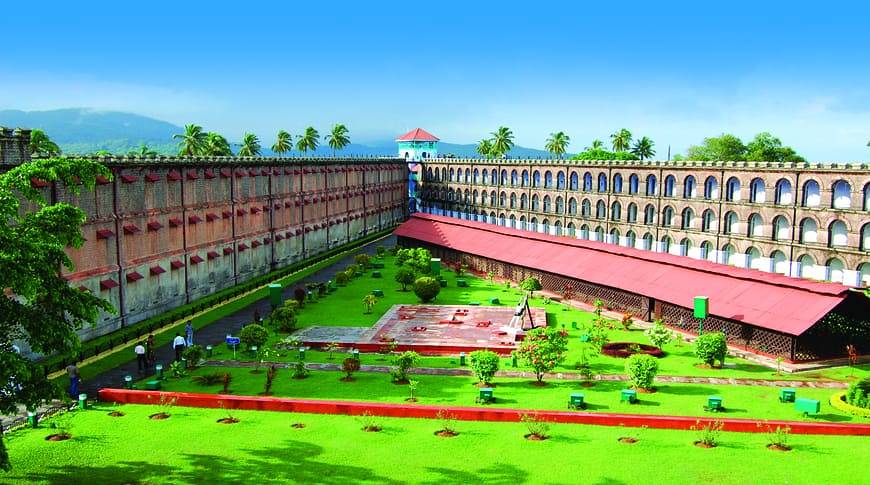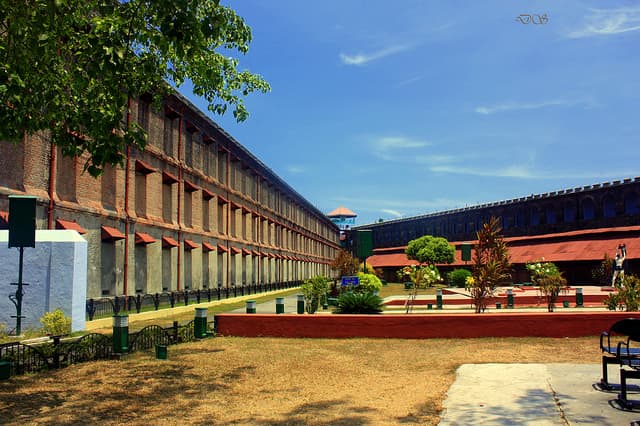Cellular Jail (Port Blair)
Cellular Jail, also known as Kalapani, is a national memorial symbolizing the sacrifice of India's freedom fighters under British rule.
Cellular Jail (Port Blair)
Cellular Jail: A Must-Visit Historical Landmark in the Andaman Islands with a Haunting Past
The Cellular Jail in Port Blair, also known as Kala Pani, is a historical prison located in the capital city of the Andaman and Nicobar Islands, India. It holds a deep significance in India’s fight for independence and stands as a grim reminder of colonial oppression. A national memorial that needs no introduction, the jail bears silent testimony to the suffering and sacrifice of freedom fighters who were imprisoned and tortured by the British.
Shortly after the First War of Independence, the British used the remote Andaman Islands to exile political prisoners and revolutionaries, keeping them far from the mainland and cutting off any hope of escape.
The History of Cellular Jail: A Dark Chapter of India’s Freedom Struggle
The history of the Cellular Jail is both poignant and powerful. Constructed between 1896 and 1906, it was designed specifically for solitary confinement, with seven wings radiating from a central watchtower. The British aimed to crush political dissent by isolating prisoners from one another. The prison housed many notable freedom fighters including Veer Savarkar, Batukeshwar Dutt, Fazl-e-Haq Khairabadi, and Yogendra Shukla.
The inhumane conditions — forced labor, minimal food rations, lack of sanitation, and physical torture — were meant to break the spirit of those incarcerated. After India gained independence, the jail was declared a national memorial, honoring those who gave their lives for freedom. Today, it functions as a museum and hosts a light and sound show that narrates its powerful history.

Architecture of Cellular Jail: A Structure Built to Isolate
The architectural design of the jail is a chilling reflection of its purpose. Built using bricks brought from Burma (modern-day Myanmar), the structure took ten years to complete. Its seven-wing layout, resembling the spokes of a wheel, radiates from a central watchtower, ensuring maximum surveillance and isolation. Each of the 696 cells was tiny, poorly ventilated, and built for solitary confinement — a system devised to prevent any communication between prisoners.
The prison was built not only to confine the inmates physically but to also crush their spirits emotionally and mentally. Today, it stands as a grim reminder of the resilience of those who were confined within its walls.
Behind the Bars: Life of the Prisoners
Life inside the Cellular Jail was filled with suffering. Prisoners lived in tiny, dimly lit cells with no contact with the outside world. Solitary confinement took a mental toll, while physical abuse and forced labor — such as stone-breaking — added to their misery. Food was scarce, and hygiene was virtually nonexistent, leading to malnutrition and disease.
Yet, despite these horrors, the prisoners found ways to resist. They wrote, communicated in secret, and even created art and literature — silent forms of rebellion that reflected their unbroken spirit. The sacrifices they made continue to inspire generations.
The Days of Veer Savarkar in Cellular Jail
Among the most renowned inmates was Vinayak Damodar Savarkar, also known as Veer Savarkar. Arrested in London in 1909 for revolutionary activities, he was brought to the Cellular Jail in 1911. Sentenced to two terms of 50 years each, he endured solitary confinement, handcuffing, and various other tortures.
Despite these dehumanizing conditions, Savarkar worked to educate fellow inmates, built a library, and even composed over 5,000 lines of poetry — all memorized, as the walls were painted to prevent him from writing. He was the first to refer to the 1857 uprising as the “First War of Indian Independence.”
The airport in Port Blair is named after him in recognition of his sacrifices. His legacy continues to be a symbol of bravery and resilience.
Exploring the Museum in Cellular Jail
The museum inside the Cellular Jail offers an immersive dive into India’s freedom movement. It houses personal belongings of inmates, letters, photographs, and important documents. These exhibits give a face to history, allowing visitors to connect emotionally with the pain and courage of the prisoners.
Artifacts and storytelling within the museum vividly highlight the sacrifices and struggles of those who lived and died within these walls. It’s not just a visit — it’s an emotional journey through India’s freedom struggle.

Experience the Light and Sound Show at Cellular Jail
The Light and Sound Show at Cellular Jail is a moving experience that brings history to life. Held in the evening, the show combines dramatic narration with lighting effects, showcasing the stories of those who suffered within the prison walls.
Available in both Hindi and English, the show evokes deep emotions of patriotism and respect. Many visitors describe it as a soul-stirring reminder of the sacrifices made for India’s independence.
Visitor Information
Entry Fee: ₹30
Camera Fee: ₹25 (Photo), ₹100 (Video)
Timings: 9:00 AM to 12:30 PM & 1:30 PM to 5:00 PM
Last Ticket Issued: 3:15 PM
Closed On: Mondays and Government Holidays
Address: GB Pant Road, Port Blair, South Andaman
Light & Sound Show: 6:00 PM (Hindi), 7:15 PM (English)
Planning Your Next Unforgettable Getaway?
Provide Your Details to Know Best Holiday Deals


